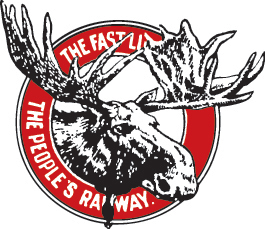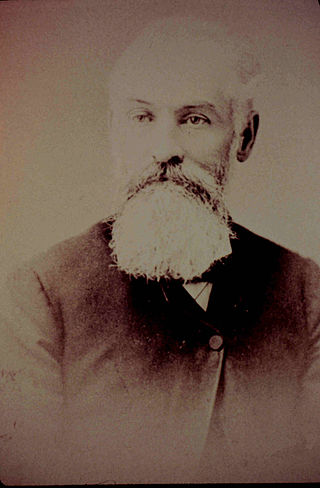Related Research Articles

Amherst is a town in northwestern Nova Scotia, Canada, located at the northeast end of the Cumberland Basin, an arm of the Bay of Fundy, and 22 km (14 mi) south of the Northumberland Strait. The town sits on a height of land at the eastern boundary of the Isthmus of Chignecto and Tantramar Marshes, 3 km (1.9 mi) east of the interprovincial border with New Brunswick and 65 km (40 mi) southeast of the city of Moncton. It is 60 km (37 mi) southwest of the New Brunswick abutment of the Confederation Bridge to Prince Edward Island at Cape Jourimain.

The Intercolonial Railway of Canada, also referred to as the Intercolonial Railway (ICR), was a historic Canadian railway that operated from 1872 to 1918, when it became part of Canadian National Railways. As the railway was also completely owned and controlled by the Government of Canada, the Intercolonial was also one of Canada's first Crown corporations.
The St. Louis Car Company was a major United States manufacturer of railroad passenger cars, streetcars, interurbans, trolleybuses and locomotives that existed from 1887 to 1974, based in St. Louis, Missouri.

The Cape Breton and Central Nova Scotia Railway is a short line railway that operates in the Canadian province of Nova Scotia. CBNS operates of main line and associated spurs between Truro in the central part of the province to Point Tupper on Cape Breton Island.

Canadian Car and Foundry (CC&F), also variously known as "Canadian Car & Foundry" or more familiarly as "Can Car", was a manufacturer of buses, railway rolling stock, forestry equipment, and later aircraft for the Canadian market. CC&F history goes back to 1897, but the main company was established in 1909 from an amalgamation of several companies and later became part of Hawker Siddeley Canada through the purchase by A.V. Roe Canada in 1957. Today the remaining factories are part of Alstom after its acquisition of Bombardier Transportation completed in 2021.

Hawker Siddeley Canada was the Canadian unit of the Hawker Siddeley Group of the United Kingdom and manufactured railcars, subway cars, streetcars, aircraft engines and ships from the 1960s to 1980s.

The Sydney and Louisburg Railway (S&L) was a Canadian railway. Built to transport coal from various mines to the ports of Sydney and Louisbourg, the S&L operated in the eastern part of Cape Breton County, Nova Scotia. The railway uses a slightly different spelling for the town of "Louisbourg".
The Devco Railway was a Canadian railway. Devco Railway operated as an unincorporated department within the Coal Division of the Cape Breton Development Corporation, also known as DEVCO; as such there is no formally incorporated entity named "Devco Railway". Devco Railway took over the operations of the Sydney and Louisburg Railway on March 30, 1968 when DEVCO expropriated the S&L as part of the assets of the Dominion Steel and Coal Corporation, or DOSCO.
The Sydney Coal Railway is a Canadian short-line railway operating in the eastern part of Cape Breton County, Nova Scotia.

Thomas Dickson Archibald was a Canadian businessman, politician, and senator.

The Cobourg Car Works, also known as the Crossen Car Works, was an early railway car and streetcar builder based in Cobourg, Ontario. The company was split off from the Ontario Foundry in 1873 by James Crossen Jr., the foundry's owner. When James died in 1890, control of the company passed to his children, who renamed it as the Crossen Car Manufacturing Company. Supplying almost all of the major Canadian railways, as well as many local regional lines, the Crossen works became the largest car company in Canada. The move to all-steel constructed and CPR's decision to open their own works led to a rapid downturn in business, and the company closed in 1913.

The Dominion Steel and Coal Corporation was a Canadian coal mining and steel manufacturing company.
The Cumberland Railway and Coal Company is a defunct Canadian industrial company with interests in coal mines in Springhill, Nova Scotia, and a railway that operated from Springhill Junction to Parrsboro.
TrentonWorks is an industrial manufacturing facility located in the town of Trenton, Nova Scotia, Canada.

Nova Scotia Light and Power Company, Limited (NSLP) was an electric and gas utility company with its head office in Halifax, Canada. The company still exists as a shell but is no longer active; however, for more than a century, it was the major producer of energy in the province of Nova Scotia, and its largest public transit operator.

Nathaniel Curry was a building contractor, manufacturer and political figure in Nova Scotia, Canada. He represented Amherst division in the Senate of Canada from 1912 to 1931.

LaPlanche Street is the historic connector between Nova Scotia and New Brunswick, Canada. Located on the Isthmus of Chignecto, LaPlanche crosses the Tantramar Marshes between Amherst, NS and Sackville, NB. Historically, it hosted the key forts of peninsular Nova Scotia and continental Acadia and witnessed the Battle of Fort Beauséjour, the key battle between the two colonies during the Seven Years' War, and the Battle of Fort Cumberland of the American Revolutionary War.

The Pugwash station is a former inter-city railway station building in the community of Pugwash, Nova Scotia, Canada. It was operated by Canadian National Railway, and now houses a branch of the Cumberland Regional Library and the North Cumberland Historical Society.

Low Point Lighthouse is an historic Canadian lighthouse marking the eastern entrance to Sydney Harbour at New Victoria, Nova Scotia, near New Waterford, Nova Scotia. This is one of the earliest and most important light stations of Nova Scotia, one of the first dozen beacons in Nova Scotia to be lit to guide mariners, a classic red-and-white lighthouse still operated by the Canadian Coast Guard.

The Highland Arts Theatre is a historic building, first constructed as a Presbyterian Church, now operating an arts and culture centre in Sydney, Cape Breton Regional Municipality, Nova Scotia, Canada. It was initially constructed as St. Andrew's Presbyterian Church.
References
- 1 2 3 "Canadian Historic Sites" . Retrieved April 19, 2013.
- ↑ Minister responsible for the Nova Scotia Heritage Property Act (29 August 2012). Notice of Registration of Property As a Provincial Heritage Property (Report). Nova Scotia Registry of Deeds: Nova Scotia Communities, Culture and Heritage, Office of the Minister. 101588508.
You are hereby notified that: 1. The building and lands located at 40 Bentinck Street, Sydney, Cape Breton Regional Municipality, Province of Nova Scotia, commonly referred to as St. Andrew's United Church, being and intended to be that the property more fully described in the Schedule "A" attached hereto, has been registered in the Provincial Registry of Heritage Property by the Minister under the Heritage Property Act on August 29th, 2012.
- ↑ "Alexander Graham Bell National Historic Site of Canada". Canadian Register of Historic Places. Retrieved 23 January 2022.
- "Rhodes, Nelson Admiral, industrialist".
- "Rhodes, Curry & Co. Ltd., Amherst, N.S." Archived from the original on 2007-05-20. Retrieved 2016-09-10.